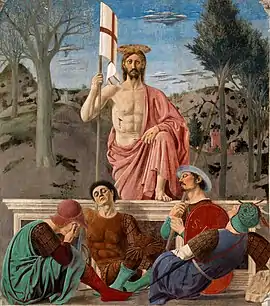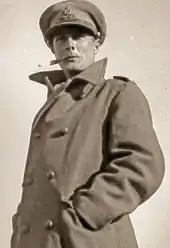| The Resurrection | |
|---|---|
 | |
| Artist | Piero della Francesca |
| Year | c. 1460s |
| Type | Fresco |
| Dimensions | 225 cm × 200 cm (89 in × 79 in) |
| Location | Museo Civico, Sansepolcro |
The Resurrection is a fresco painting by the Italian Renaissance master Piero della Francesca, painted in the 1460s in the Palazzo della Residenza in the town of Sansepolcro, Tuscany, Italy.
Piero was commissioned to paint the fresco for the Gothic-style Residenza, the communal meeting hall[1] which was used solely by Conservatori, the chief magistrates and governors, who, before starting their councils, would pray before the image. "The secular and spiritual meanings of the painting were always intimately intertwined."[2][3] Placed high on the interior wall facing the entrance, the fresco has for its subject an allusion to the name of the city (meaning "Holy Sepulchre"), derived from the presence of two relics of the Holy Sepulchre carried by two pilgrims in the 9th century. Piero's Christ is also present on the town's coat of arms.[4]
Composition
Jesus is in the centre of the composition, portrayed in the moment of his resurrection, as suggested by the position of the leg on the parapet of his tomb, which Piero renders as a classical sarcophagus. His stern, impassive figure, depicted in an iconic and abstract fixity (and described by Aldous Huxley as "athletic"), rises over four sleeping soldiers, representing the difference between the human and the divine spheres (or the death, defeated by Christ's light). His figure in the commune's council hall "both protects the judge and purifies the judged" according to Marilyn Aronberg Lavin.[5] The landscape, immersed in the dawn light, has also a symbolic value: the contrast between the flourishing young trees on the right and the bare mature ones on the left alludes to the renovation of men through the Resurrection's light.
.jpg.webp)
Andrew Graham-Dixon notes that apart from the wound, Christ's "body is as perfectly sculpted and as blemish-free as that of an antique statue. But there are touches of intense humanity about him too: the unidealised, almost coarse-featured face; and those three folds of skin that wrinkle at his belly as he raises his left leg. Piero emphasises his twofold nature, as both man and God."[2]
The guard holding the lance is depicted sitting in an anatomically impossible pose, and appears to have no legs. Piero probably left them out so as not to break the balance of the composition.[6]
According to tradition and by comparison with the woodcut illustrating Giorgio Vasari's Lives of the Painters, the sleeping soldier in brown armor on Christ's right is a self-portrait of Piero. The contact between the soldier's head and the pole of the banner[7] carried by Christ is supposed to represent his contact with the divinity.
The composition is unusual in that it contains two vanishing points. One is in the center of the sarcophagus, because the faces of the guards are seen from below, and the other is in Jesus's face. The top of the sarcophagus forms a boundary between the two points of view, and the steepness of the hills prevents the transition between the two points of view from being too jarring.[8]
Near-destruction

Sansepolcro was spared much damage during World War 2 when British artillery officer Anthony ('Tony') Clarke defied orders and held back from using his troop's guns to shell the town. Although Clarke had never seen the fresco, his diary records his shock at the destruction in Monte Cassino and, apparently remembering where he had read of Sansepolcro, ordered his men to hold fire just as methodical shelling had begun. Gay and art-loving,[9] Clarke had read Huxley's 1925 essay describing the Resurrection, which states: "It stands there before us in entire and actual splendour, the greatest picture in the world."[10] It was later ascertained that the Germans were in retreat from the area – the bombardment had not been necessary, though Clarke had not known this when he ordered the shelling stopped. The town, along with its famous painting, survived. When the events of the episode eventually became clear, Clarke was lauded as a local hero and to this day a street in Sansepolcro bears his name.[9]
See also
- 100 Great Paintings, 1980 BBC series
References
- ↑ The residenza was returned by Florentine authorities to the citizens of Sansepolcro, Tuscany, in 1459 as a sign of the restoration of some measure of autonomy to the Borgo. Dates as given in Aronberg Lavin, Marilyn (2002). Piero della Francesca. Phaidon. pp. 234ff. ISBN 978-0714838526.
a document of 1474 concerning structural repairs to the building mentions the painting
- 1 2 Andrew Graham-Dixon. "ITP 157: The Resurrection by Piero della Francesca".
- ↑ In moving of the fresco, an inscription was lost. Aronberg Lavin 2002, p. 241.
- ↑ A large chunk of stone stands in the lower right hand of the fresco, "and thus we are told to recognize this stone as the founding relic carried here from the Holy Land by Saints Arcano and Egidio". Aronberg Lavin 2002, p. 243.
- ↑ Aronberg Lavin 2002, p. 244.
- ↑ The Private Life of a Masterpiece – Piero della Francesca's The Resurrection (2006). Quote: "You are totally absorbed into reality, in a way, of the image, and you don't notice – it's perfectly true – that one of the guards has no legs. The arrangement of the guards is so perfect, so clever, so symmetrical, so balanced – in terms of colour, in terms of form – that actually the fact that he's got no room to put these legs in ceases to be important, and you don't notice for ages and ages and ages that he's legless."
- ↑ The banner of a red cross on a white field was a convention observed by both Andrea Mantegna (in his San Zeno altarpiece) and Giovanni Bellini (in his Resurrection in Berlin); illustrations, for example, in Aronberg Lavin 2002, figures 154, 155
- ↑ Kline, Morris (1953). Mathematics in Western Culture. Great Britain: Pelican. p. 166.
- 1 2 Butcher, Tim (24 December 2011). "The man who saved The Resurrection". BBC News. Retrieved 24 February 2012.
- ↑ Huxley, Aldous. "The Best Picture" Archived 2013-04-18 at the Wayback Machine, 1925.
Bibliography
- Frosinini, Cecilia (2022). La Resurrezione di Piero della Francesca: il restauro della "pittura più bella del mondo", tra memorie di storia civica e scoperte, Edifir ISBN 9788879709729
- Manescalchi, Roberto (2008). Il Cristo Risorto di Piero immagini rare e desuete. Sansepolcro: Aboca Museum.
- Manescalchi, Roberto (2008). Amintore Fanfani e Giulio Gambassi, Il Cristo Risorto di Piero della Francesca: Una battaglia per l'arte. Firenze: Grafica European Center of Fine Arts.
- Refice, Paola. "La Resurrezione: questioni iconografiche", in 1492. Rivista della Fondazione Piero della Francesca», vol. IX (2016), no. 1, pp. 15–33
- Refice, Paola. "La frammentaria epigrafe dipinta nella Resurrezione di Piero della Francesca: un'ipotesi di ricostruzione", in Prospettiva, nos. 163/164 (July–October 2016), pp. 95–97
- Zuggi, Stefano (1991). Piero della Francesca. Milan: Elemond.
External links
 Media related to Resurrection by Piero della Francesca at Wikimedia Commons
Media related to Resurrection by Piero della Francesca at Wikimedia Commons